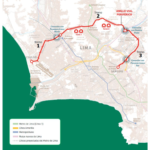Terminology Used in Highway Design
AADT (Average Annual Daily Traffic) – The total yearly traffic volume divided by the number of days in the year.
AASHTO – Abbreviation for American Association of State Highway and Transportation Officials.
Acceleration Lane – A speed change lane to enable a vehicle entering a roadway to increase its speed to merge with through traffic.
Aggregates (Coarse) – Aggregates predominantly retained on the 4.75 mm (No. 4) sieve.
Aggregates (Fine) -— Aggregates passing the 9.5 mm (3/8 in.) sieve and almost entirely passing the 4.75 mm. (No. 4) sieve, and predominantly’ retained on the 0.075 mm (No. 200) sieve.
Arterial Highway or Street — A highway primarily for the movement of through traffic. It may have either grade intersections with other highways or grade separated intersections.
The hierarchy of roads is freeways/expressways/motorways – arterial roads – collector roads – local access roads
Auxiliary Lane – The portion of the roadway adjoining the travelled way for weaving, truck climbing, speed change, or for other purposes supplementary to through traffic movement.
Axle Load – The total load transmitted by all wheels on a single axle extending across the full width of the vehicle. Tandem axles 1 m or less apart shall be considered as a single axle.
Binder Course – A plant mix of graded aggregate and bituminous material placed between the base course and a bituminous surface course.
Bituminous Material – A general term encompassing asphalt cements, cutbacks, and emulsified asphalts.
Bridge – A structure exceeding 6 m clear span measured along the centreline of the roadway, which carries traffic over a watercourse or opening.
California Bearing Ratio (CBR) — The ratio of the force required to penetrate a soil mass with a circular piston of 5 cm diameter to the force required to penetrate a mass of high-quality crushed stone with the same piston. The rate of penetration in both cases is 1.27 mm per minute.
Camber – Where the centreline of a carriageway is higher than the edges of the carriageway. Usually occurs on straight sections of carriageway. Required to enable water to drain off the carriageway surface.
Capacity – The maximum number of vehicles that have a reasonable expectation of passing over a given section of a lane or a roadway during a given time period under prevailing roadway and traffic conditions.
Carriageway– The hardened surface of a road used for the movement of vehicles.
Central reserve – The physical area that separates the opposing traffic lanes of a dual carriageway or motorway.
Channelisation – The separation of traffic flow into definite paths, by means of traffic markings or islands.
Channelised Intersection – A grade intersection where traffic is directed into definite paths by islands.
Climbing Lane — An additional traffic. lane provided for slow moving vehicles (on the up-grade side of a. highway.
Cloverleaf Interchange – A four leg interchange with loops for left turns, and other connections for right turns. A full cloverleaf has ramps for two turning movements in each quadrant.
Collector Highway or Street – A highway that provides a combination of land access and movement of through traffic. A design classification for these type roads.
Crash Cushion (Impact Attenuator) – A device placed before a fixed roadside object to absorb and dissipate collision energy thus reducing the severity of injuries and property damage.
Crossfall – The value of the fall from either the centreline to the edge (camber) or from edge to edge (superelevation). Usually expressed as 1 in x (e.g., 1 in 40), or as percentage (e.g., 2.5%).
Cross Walk – Any portion of a roadway at an intersection or elsewhere distinctly indicated for pedestrian crossing signs and by lines or other markings on the surface.
Curve Widening – The widening of the highway travelled way on sharp curves to compensate for the fact that the rear wheels of a vehicle do not follow exactly in the track of the front wheels.
Cutting/Embankment – A situation where the adjacent ground surface is higher than (Cutting) or lower than (Embankment) the carriageway
Deceleration Lane – A speed change lane that enables a vehicle to slow to a safe exit speed when making an exit turn.
Design Hour Volume (DHV) – The future two-way hourly traffic volume for use in design, usually the 30th highest hourly volume of the design year (30 HV).
Design Period – The number of years of intended service life of a facility before the first major rehabilitation.
Design Speed – A speed selected for purposes of design and correlation of the geometric features of a highway and a measure of the quality of service offered by the highway. It is the highest continuous speed where individual vehicles can travel with safety upon a highway when weather conditions are favourable, traffic density is low and the geometric design features of the highway are the governing conditions for safe speed.
Design Vehicles – (1) Selected motor vehicles with the weight, dimensions, and operating characteristics used to establish highway design controls for accommodating vehicles of designated classes. (2) The design vehicle is a frequent user of a given street and dictates the minimum required turning radius
Diamond Interchange – A four leg interchange with a single one-way ramp in each quadrant. All left turns are made directly on the minor roadway.
Dual carriageway – A carriageway where traffic travelling in opposite directions is physically separated. Because there is a physical separation there is usually a minimum of two lanes for each direction of travel.
EAL (Equivalent Axle Load) – The effect on pavement performance of any combination of axle loads of varying magnitude, equated to the number of reference single-axle loads required to produce an equivalent number of repetitions of an 8-ton single axle.
Expressway – A multilane, divided highway designed to move large volumes of traffic at high speeds under free flow conditions. Expressways have full control of access with grade separated interchanges.
Footway – part of the highway over which the public have a right of way for the passage of pedestrians.
Frontage Road – A road contiguous to a controlled access highway so designed as to intercept, collect, and distribute traffic desiring to cross, enter, or leave the controlled access highway and to furnish access to adjacent property.
Geometric Design – The arrangement of the visible elements of a road, such as alignment, grades, sight distances, widths, slopes, etc.
Hardshoulder – A wide paved area to the nearside of a dual carriageway to allow for broken down vehicles to pull completely out of the line of traffic. Also used as access for emergency vehicles and additional road space during temporary traffic management.
Hardstrip – A narrow paved area to the nearside and/or offside of a carriageway to allow for a broken-down vehicle to partially pull out of the line of traffic. Also used as additional road space during temporary traffic management, snow and water collection and overrun facility for driver error and evasive action.
Horizontal Curve – A circular curve or transitional by means of which a highway can change direction to the right or left.
Interchange — A system of interconnecting roadways in conjunction with one or more grade separations, providing for the movement of traffic between two or more roadways on different levels.
Intersection – The area common to two or more highways that come together at an angle.
Island – A defined area between lanes for control of vehicle movements or for pedestrian refuge.
Junctions – Connection of two or more roads.
At Grade Junction – Connection between the two roads takes place at a single level. Usually involves one road giving way to another.
Roundabout – Special type of at grade junction consisting of a circulatory carriageway with entering traffic giving way to circulating traffic, merging and then exiting at another connector.
Grade Separated Junction – Junction where the major traffic flow is un-interrupted, and with the connecting traffic leaving and joining via slip roads connected to a roundabout, or other junction type, on a different level.
Level of Service – A qualitative measure of the effect of a number of factors, such as operating speed, travel time, traffic interruptions, freedom to manoeuvre and pass, driving safety , comfort, convenience and operating costs on the service. a. highway renders to its users.
Median – The portion of a divided highway separating the travelled ways for traffic in opposite directions.
Motorway – A special category of dual carriageway for fast moving traffic, with limited access, restricted by legal order.
Overpass – A grade separation where the highway passes over an intersecting highway or railroad.
Passenger Car Equivalent – The number of passenger cars displaced in the traffic stream by a truck or bus. This displacement is caused by the difference between truck or bus speeds, and passenger car speeds on up-grades, and by the larger sizes of trucks and buses compared to passenger cars.
Passing Sight Distance – Minimum sight distance that must be available to enable the driver of one vehicle to pass another safely and comfortably, Without interfering with the speed of an oncoming vehicle traveling at the design speed should it come into View after the overtaking manoeuvre is started.
Prime Coat – The application of a low viscosity liquid bituminous material to znl absorbent surface, preparatory to any subsequent -treatment, for the purpose of hardening or toughening the surface and promoting adhesion between it and the superimposed construction.
Ramp (or Slip Road)– A short roadway, usually one way, to accomplish transfer movements within an interchange from the arterial highway or expressway to the crossroad.
Refuge Island – An island in a wide intersection to provide refuge for pedestrians. Also, a place for transit passengers to load and unload from a bus.
Right-of-Way (ROW) (1) Land generally publicly owned, acquired for and devoted to transportation purposes. (2) The privilege of the immediate use of the highway. The right of one vehicle or pedestrian to proceed in a lawful manner in preference to another vehicle or pedestrian.
Ring Road — An arterial highway for carrying traffic around an urban area or portion thereof.
Road (or Highway) – Includes any road over which the public has a right to pass and includes cycleways, footpaths and adjacent verges, bridleways as well as the road itself.
Seal Coat – A bituminous coating with aggregate applied to the surface of a pavement for the purpose of waterproofing and preserving the surface, relivening a previous bituminous surface, altering the surface texture of the pavement, or providing resistance to traffic abrasion.
Separator – An area or a device located longitudinally between two roadways to separate traffic flowing in the same or opposite directions, and so designed as to discourage or prevent passage by vehicles from the traffic lanes on one side of the separator to those on the other.
Shoulder – The portion of roadway contiguous with the travelled way for accommodation of stopped vehicles for emergency use, and for lateral support of base and surface courses.
Side slope – The slope of the ground between the back of a verge and the top of a cutting or the bottom of an embankment.
Single carriageway – A carriageway where traffic travelling in opposite directions is not physically separated
Soil Stabilization – Measures taken to eliminate or minimize the erosion of soil or to improve its supporting capacity.
Specifications – The formal directions, provisions, and requirements that outline the work to be done, the way it is to be done, the character of materials and mixtures to be used, or the results to be obtained.
Stopping Sight Distance – The distance required by a driver of a vehicle, traveling at a given speed, to bring his vehicle to a stop after an object on the roadway becomes visible. It includes the distance travelled during the perception and reaction times, as well as the vehicle braking distance.
Subbase – The layer or layers of specified or selected material of designed thickness placed on a subgrade to support a base course.
Subgrade – (1) The top 30 cm layer of embankments or’ excavated. areas on which the pavement structure including shoulders is constructed. (2) The top of a roadbed upon which the pavement structure and shoulders are constructed.
Superelevation – (1) Where one edge of the carriageway is higher than the other edge of the carriageway. Usually occurs on the circular arc sections of the carriageway. Required to help vehicles negotiating a bend to remain on the carriageway. (2) – The elevating of the outside edge of a curve to partially offset the centrifugal force generated when a vehicle rounds the curve.
Surface Course – One or more layers of a pavement structure designed to accommodate the traffic load, the top layer of which. resists skidding, traffic abrasion, and the disintegrating effects of climate. The top layer is sometimes called Wearing course.
Tack Coat – An application of bituminous material to an existing surface to provide bond with a superimposed course.
30th Highest Annual Hourly Volume – The hourly volume that is exceeded by 29 hourly volumes during a designated year.
Time of Concentration – The time required for storm runoff to flow from the most remote point of a drainage area to the point ‘under consideration’. It is usually associated with the design storm.
Transition Curve (Spiral) – A curve of variable radius intended to affect a smooth transition from tangent to curved alignment.
Underpass – A grade separation where the highway passes under an intersecting highway or railroad.
Verge – A nominally flat area between the paved carriageway and side slope, or in the absence of a side slope between the carriageway and the highway boundary or bridge abutment or parapet.
Weaving – The crossing of traffic streams moving in the same general direction. accomplished by merging and diverging.
Weaving Sections – Highway segments where the pattern of traffic, entering and leaving at contiguous points of access results in vehicle paths crossing each other.







